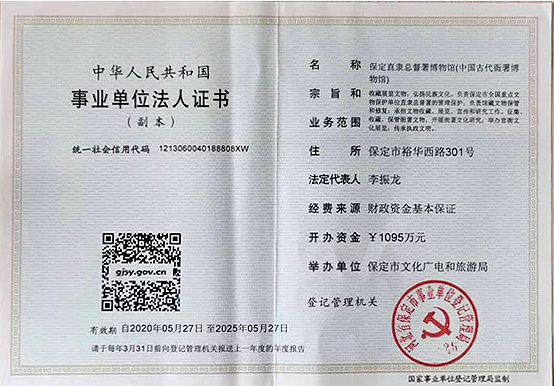About us
- Categories:About us
- Time of issue:2020-05-15 00:00:00
- Views:0
Description:
Information
The Zhili Governor's Office, firstly built in the seventh year of the Emperor Yongzheng’s reign (A.D.1729), was the working venue for the top military and administrative officer of Zhili Province (today’s Hebei Province) in Qing Dynasty, and is now the only existing provincial administrative building complex that is relatively well preserved as a whole.
Covering an area of 30,000 square meters and facing south, the whole complex was strictly built according to the architectural rules of Qing Dynasty, divided by north and south paths, which were usually used for sounding the night watches, and three north-south paths, called eastern, central and western lines. The main buildings are along the central line, including the imperatorial main hall, the solemn second hall, the elegant official residence and garden-like main quarters. Along the eastern and western lines are auxiliary buildings such as the officer’s courtyard, guest rooms, the flower hall, the arrow path, etc., all of which feature fabric tiles and flush gable roofs, making it a typical administrative building complex in north China.
The imperatorial main hall, a symbol of the feudal governor’s authority, was where the governor conducted major administrative activities and held grand ceremonies; the solemn second hall was the place for the governor to meet officials from other places and to review cases; the elegant official residence was where the governor handled daily government affairs and examined documents; and the garden-like main quarters were the living quarters of the governor-general and his family.
Zhili Governor's Office was important in history as it held a strategic location for the capital city and its environs. During its 187 years operation, 74 governors served 99 terms here, all of whom were significant officials of the central court, including such famous figures as Fang Guancheng, Liu Yong, Rong Lu, Zeng Guofan (Tseng Kuo-fan), Li Hongzhang (Li Hung-chang) and Yuan Shikai. Among them, Li Hongzhang served for the longest term, as long as 25 years. These significant officials from the central court, from here, released orders to all parts of the province, which made the Office closely related to a lot of important events in the Qing Dynasty. Being the concentration and witness of history, the Governor-general’s Office has a lot historical stories to offer.

“A governor-general’s office tells half of the Qing Dynasty’s history.” It’s no boasting to use this expression to describe the abundant historical materials offered by the Office. Zhili Governor's Office is welcoming visitors from home and abroad with its elaborate layout, grand size, unique architectural style and rich historical contents.
The Zhili Governor's Office, firstly built in the seventh year of the Emperor Yongzheng’s reign (A.D.1729), was the working venue for the top military and administrative officer of Zhili Province (today’s Hebei Province) in Qing Dynasty, and is now the only existing provincial administrative building complex that is relatively well preserved as a whole.
Covering an area of 30,000 square meters and facing south, the whole complex was strictly built according to the architectural rules of Qing Dynasty, divided by north and south paths, which were usually used for sounding the night watches, and three north-south paths, called eastern, central and western lines. The main buildings are along the central line, including the imperatorial main hall, the solemn second hall, the elegant official residence and garden-like main quarters. Along the eastern and western lines are auxiliary buildings such as the officer’s courtyard, guest rooms, the flower hall, the arrow path, etc., all of which feature fabric tiles and flush gable roofs, making it a typical administrative building complex in north China.
The imperatorial main hall, a symbol of the feudal governor’s authority, was where the governor conducted major administrative activities and held grand ceremonies; the solemn second hall was the place for the governor to meet officials from other places and to review cases; the elegant official residence was where the governor handled daily government affairs and examined documents; and the garden-like main quarters were the living quarters of the governor-general and his family.

Zhili Governor's Office was important in history as it held a strategic location for the capital city and its environs. During its 187 years operation, 74 governors served 99 terms here, all of whom were significant officials of the central court, including such famous figures as Fang Guancheng, Liu Yong, Rong Lu, Zeng Guofan (Tseng Kuo-fan), Li Hongzhang (Li Hung-chang) and Yuan Shikai. Among them, Li Hongzhang served for the longest term, as long as 25 years. These significant officials from the central court, from here, released orders to all parts of the province, which made the Office closely related to a lot of important events in the Qing Dynasty. Being the concentration and witness of history, the Governor-general’s Office has a lot historical stories to offer.
“A governor-general’s office tells half of the Qing Dynasty’s history.” It’s no boasting to use this expression to describe the abundant historical materials offered by the Office. Zhili Governor's Office is welcoming visitors from home and abroad with its elaborate layout, grand size, unique architectural style and rich historical contents.

Scan the QR code to read on your phone

Address:
No. 301, Yuhua West Road, Baoding City, Hebei Provinc

Tel:

Serviceline:

Complaints hotline:
Copyright © Baoding Museum of Zhili Govern-general’s Office All Rights Reserved. 冀ICP备2021010014号-1 www.300.cn


